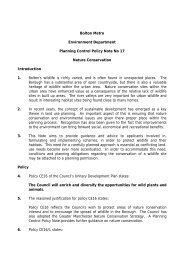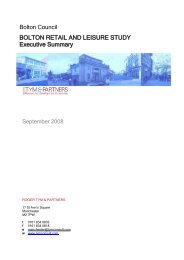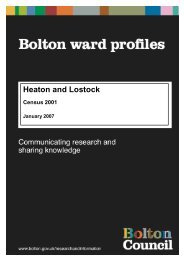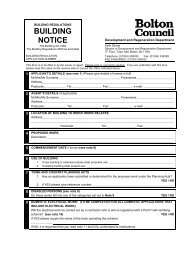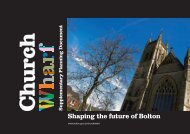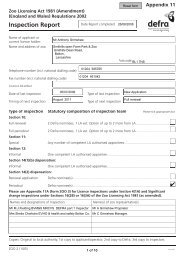Town Hall Conservation Area - Bolton Metropolitan Borough Council
Town Hall Conservation Area - Bolton Metropolitan Borough Council
Town Hall Conservation Area - Bolton Metropolitan Borough Council
You also want an ePaper? Increase the reach of your titles
YUMPU automatically turns print PDFs into web optimized ePapers that Google loves.
During the Civil War in the 1640s, <strong>Bolton</strong> supported Parliament against Charles I and the<br />
Earl of Derby; the town was staunchly protestant and had a growing merchant class. In<br />
1643, following his defeat at Preston, the Earl of Derby unsuccessfully attacked the town<br />
but a third attack in 1644 succeeded and <strong>Bolton</strong> was sacked and burned. The Earl of<br />
Derby was subsequently tried in <strong>Bolton</strong>, and beheaded at the Market Cross on<br />
Churchgate in 1651.<br />
The town grew slowly until the late 18 th century, when the rapidly expanding cotton<br />
industry brought accelerated growth and prosperity to the town. The 1793 map of <strong>Bolton</strong><br />
Appendix 2 shows a layout that was essentially that of the medieval town, with limited<br />
expansion to the south of Deansgate (the River Croal and Little <strong>Bolton</strong> limited<br />
northwards growth). Beyond the edge of the built-up area were orchards, gardens and<br />
meadows. These were developed as the town grew more quickly from the late 18th<br />
Century onwards. At this date, a series of long narrow lanes ran south from Deansgate,<br />
a pattern that reflected the layout of medieval burgage plots. These lanes included<br />
Spring Gardens, Howell Croft, Old <strong>Hall</strong> Street and Oxford Street, and they were later<br />
linked by short east-west lanes including Barn Street, Hotel Street and Ashburner Street.<br />
The old street names reflect the town's rural origins and its later industrialisation.<br />
Ashburner Street was probably so named because it originally led to a number of<br />
engineering works. Barn Street was originally the site of Barn Meadow. Spring Gardens<br />
ran south from Deansgate to Great Moor Street and was the site of gardens, which were<br />
later developed for engineering works. Old <strong>Hall</strong> Street was named after <strong>Bolton</strong>'s first<br />
poor house, The Old <strong>Hall</strong>, which was built by the overseers of Great <strong>Bolton</strong> in 1785.<br />
Howell Croft is probably named after the Howell Family who owned a croft or meadow in<br />
this area at the turn of the 19th Century when the street was first laid out.<br />
<strong>Town</strong> <strong>Hall</strong> conservation area in the 19 th century<br />
In 1810 an area of meadows between Howell Croft and New Acres was acquired as a<br />
new market place, as the medieval market on Deansgate and Churchgate had become<br />
congested. The new market opened in 1826 on a square initially known as New Market<br />
Place, shown on Baines‟ 1824 map (Appendix 2). Oxford Street was cut through from<br />
Deansgate in the early 19 th century to provide access to New Market Place from the<br />
north and Newport Street was laid out from the south, named after Viscount Newport of<br />
the Bridgeman family whose title was conferred in 1815.<br />
Once established, the area around the market became an important focus of commercial<br />
activity. The first <strong>Bolton</strong> Savings Bank opened on Oxford Street in 1818, with an<br />
assembly room, and in 1824, the Exchange Buildings were built on the south-east corner<br />
of the square, designed by Richard Lane in Greek Revival style. The east side of the<br />
square was developed with a long terrace of shops and town houses. Along the north<br />
side of the square ran an east-west street named Barrack Lane on the 1793 map, New<br />
Market Street on Baines‟ 1824 map, and shown as Hotel Street on the 1849 OS map<br />
(Appendix 2). The Victoria and the Commercial Hotels were on this street in the 19 th<br />
century. Throughout the 19 th century, the area west and east of the square was dense<br />
with narrow north-south lanes built-up with terraced workers‟ housing (Fig.2). Between<br />
Black Horse Street and Spring Gardens there was a large foundry, and the 1890s map<br />
(Appendix 2) also shows a tobacco manufacturers between Howell Croft and Old <strong>Hall</strong><br />
Street north of the Square.<br />
July 2008 6




